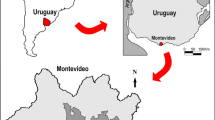Summary
This investigation was aimed at studying the mycoflora present in Huelva (South West Spain), a highly polluted region. The study was carried out using the Cour trap and it is worth pointing out that the chemical treatment performed following the Cour methodology might destroy a certain percentage of spores. We analyzed the presence and biannual changes (10 April 1989 to 8 April 1991) of fungal spores of three genera, seventeen form genera, and four groups lacking taxonomic category, looking at their morphology: ascospores, basidiospores, and unidentified unicellular and multicellular spores. Special attention was given to agriculturally interesting groups. The results obtained were correlated with meteorological parameters (rainfall, minimum temperature and humidity).
Similar content being viewed by others
References
Alexopoulos C.J., Mins C.W., (1985) —Introducción a la micologia. Ed. Omega, Barcelona.
Cour P., (1974) —Nouvelles techniques de dètection des flux e des retombées polliniques: étude de la sédimentation des pollens déposès à la surface du sol. Pollen et spores,16:103–141.
Daoud A., (1980) —Mise en evidence d'un rythme biennal dans la pollinisation de Fagus silvatica. These Doctorel. Montpellier.
Ellis M.B., (1976) —More dematiaceaes, hyphomicetes. C.A.B. Kew.
Font Tullot I. (1983) —La climatologia de España y Portugal. Instituto Nacional de Meteorologia, Madrid.
Gonzalez Fragoso R., (1927) —Botanica Criptogàmical Agricola. Ed. Espasa Calpe S.A.
Grant Smith E., (1984) —Sampling and identifying allergenic pollens and molds. Blewstone press, San Antonio, Texas.
Hurtado I., M. Reigler-Goihman, (1986) — Air sampling studies in a tropical area.Grana,25 (1): 68–73.
Nilsson S., (1983) —Atlas of airbone fungal spores in Europe. Springer-Verlag, Berlin, Heidelberg, New York.
Nogales M.T., Galan C., Ruiz de Clavijo E., Dominguez E., (1985) —Variaciòn estacional del contenido de esporas de Cladosporiumen la Atmosfera de Cordoba. Anales de la A.P.L.E.,2:339–34.
Rivas Martinez S., (1987) —Memoria del mapa de series de vegetación de España. Icona, Madrid.
Schumacher M.J., McClathy J.K., Farr R.S., Minden P., (1975) —Primary interaction between antibody and components of Alternaria.Immunological and chemical characteristics of labelled antigens. Journal Allergy Clin. Immunol.,56(1):39–53.
Author information
Authors and Affiliations
Rights and permissions
About this article
Cite this article
Minero, F.J.G., Romano, M.L.G., Romero, F. et al. Airborne fungal spores trend over a highly polluted area of south-west Spain using Cour's trap. Aerobiologia 9, 39–45 (1993). https://doi.org/10.1007/BF02311369
Issue Date:
DOI: https://doi.org/10.1007/BF02311369




